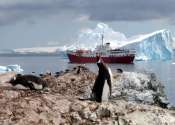Keeping warm: Coordinated movements in a penguin huddle
To survive temperatures below -50 C and gale-force winds above 180 km/h during the Antarctic winter, Emperor penguins form tightly packed huddles and, as has recently been discovered – the penguins actually coordinate ...









